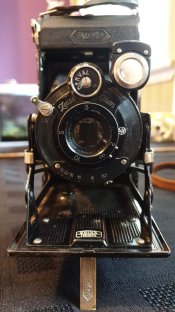Many if not most front cell focusing lenses from this period had multiple thread starts. This accommodated being able to orient the focus scale without the very costly synchronized threads that would guarantee that orientation. It also allowed a fast pitch thread, to get from infinity to closest focus in less than one turn without an expensive and mechanically weak skip thread. Since focus is determined by the depth dimension between the front element and the second one (for triplets like this one and Tessar types, at least), as long as that front element goes to the correct depth the focus will be right.
If the element stops at the wrong point (it should normally reach the infinity mark when all the way in) unscrew it and keep turning counter-clockwise until you hear/feel a click, then screw back in -- this will switch you to the next thread start. If still not right, repeat this process until the scale marker is on the infinity mark with the element fully in.
Then verify the focus (aperture wide open) with a loupe, frosted glass or plastic sheet at the film plane and the lens locked open on B (with a locking cable release). Infinity should be critically sharp for objects at least half a kilometer away.






